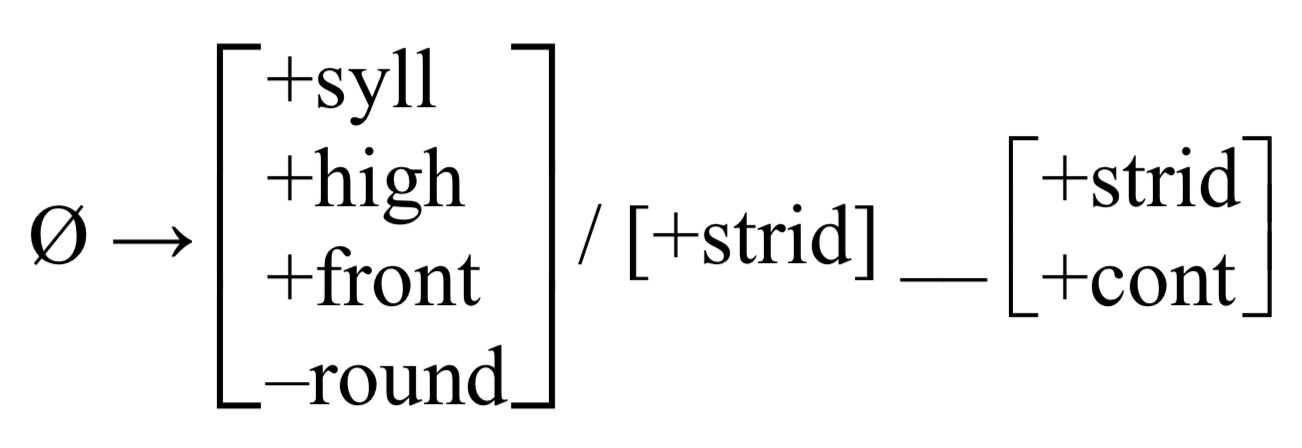### Will's Wednesday Office Hours are cancelled today and the 30th Temporary office hours Tuesday 29th 12:30-1:30 --- ### "Surface Allophones" vs. Phonemes - Every sound comes to the surface as an allophone - You never produce a phoneme, just the surface allophone which has the same form as the underlying phoneme. - "These two sounds are phonemes" is not the most accurate phrasing - "These two sounds represent two different phonemes" - It's a nitpick, but it's a nit I should be better at picking. --- ### It's "Complementary" distribution, not "Complimentary" - This is Will's very favorite typo - Allophones form a complementary set, which completely cover the options - Allophones do not tell you that your hair looks great today --- # Writing Phonological Rules (well) ### Will Styler - LIGN 111 --- ### Today's Plan - Writing phonological rules - Writing *graceful* phonological rules --- # Phonological Rules --- ### So, you've figured out that sounds are allophones of the same phoneme! - They're in a *complementary* distribution - You can predict which one will show up based on the environment - **How do I express that prediction to somebody else?** --- ### Phonological Rules You describe the distribution of the allophones of a phoneme with phonological rules --- ### First, a note on notation - We're going to differentiate words in IPA between // and [] - /tap/ means 'top' at an abstract level ('Underlying form'). - [tap] means that sequence of sounds at a surface level ('Surface form'). - /tap/ exists in the speaker's mind, [tap] exits a person's mouth - More later... --- ### Transformation has a format - We need to know what it starts as - What it turns into - And when that transformation takes place --- /Starting State/ -> [Ending State] / [When the transformation happens] --- ### /Remus Lupin/ -> [Wolf] / [Full moon]  --- ### /Optimus Prime/ -> [Truck] / [Time to Roll Out]  --- ### For ANY transformation, you want to know... - What it starts out as - What it ends up as - What conditions or environment triggers it --- ### Phonological Rule Format - "X turns into Y in environment Z" - “X -> Y” means “X turns into Y” - -> is an arrow. -> is just easy to type. - Then the “/” which means “in the environment” - Then you add a blank, representing where the sound goes that's getting transformed “__” - ... And you position that blank relative to the conditioning environment. --- ### For now, you can use natural classes, or features - Once we've learned features, we're going to have you use them - I'll present both --- ### If /n/ turns to an /ŋ/ before dorsal consonants... - /n/ -> [ŋ] / __ [dorsal C] - If it happened after dorsal sounds... - /n/ -> [ŋ] / [dorsal C] __ --- ### Some Basic Phonological Rules - Bruce Wayne --> Batman / [Crime]__[Crime] - /t/ -> /t̪/ /__[dental C] - /ej/ -> [ej:] / __[+voice] - /V/ -> [Ṽ] / __[+nasal] --- ### Word Boundaries - "#" indicates a word boundary - Words *actually* look like [#kʰæt#ʃoʊ#] - The environment "__#" means "at the end of the word" - "Right before the word boundary" - The environment "#__" means "at the start of the word" - "Right after the word boundary" - Same thing goes for syllable (".") and morpheme ("+") boundaries --- ### Other Symbols - “V” means “any vowel” - “C” means “any consonant” - "ø" means "Nothing" - α β γ are used for matching --- ### Insertion/Deletion - "ø" means "Nothing" - /t/ -> ø / __# - "t disappears at the end of the word" - ø -> [t] / V__V - "t appears any time two vowels are directly adjacent" --- ### Alpha notation - "These sounds should match for this feature" - /n/ -> [ŋ] / __[Velar C] - /n/ -> [n̪] / __[Dental C] - /n/ -> [m] / __[Bilabial C] - /n/ -> [n] / __[Alveolar C] - /n/ -> [αplace] / __[C αplace] --- ### Sonorants match the nasality of the preceding C - [+son] -> [αnasal] / [+cons, αnasal]__ --- ### Alpha Notation - You can use α β γ (and so forth) for any features - If you just need one, use [α] (Greek letter alpha) - If you need to match on two independent features, use [β] - "Given two vowels of the same height, the second vowel is rounded if and only if the first vowel is rounded." - [+syll, αhigh] → [βround] / [αhigh, βround]__ --- ### Set Notation - Groups of sounds can be presented as ordered sets - /p t k/ -> [ɸ θ x] / V__# - This is different from /p t k/ -> [θ x ɸ] / V__# --- ### Feature Matrices - Sometimes, you need to list multiple features - One approach:  - The other: ø -> [+syll,+high,+front,-round] / [+strid]__[+strid,+cont] - **These two rules say the same thing. They are equivalent.** - I'll post a fancy bracketing in word guide on Canvas --- ### Don't forget the brackets - V -> [+nasal] / [Nasal C]__ - V -> [+nasal] / NasalC__ --- ### Parentheses mark optional elements - /d/ -> [z] / __(C)# - "d becomes z before a word boundary, or before a C followed by a word boundary" - V -> [αround] / [+syll, αround](C)__ - Vowels match the rounding of the previous vowel, even if there's an intervening consonant - V -> [αround] / [+syll, αround]([-syll,-nasal])__ - Vowels match the rounding of the previous vowel, even if there's an intervening non-nasal consonant --- ## Let's Practice! --- ### Formalize the following rules (Assume that groupings represent complete natural classes) 1: /d/ becomes a /n/ immediately after a nasal vowel 2: /i/ and /u/ become /ɪ/ and /ʊ/ at the end of the word, even if there's a nasal before the word's end. 3: /d/ will turn into /b/ or /d/ or /g/ when after /m/ or /n/ or /ŋ/, respectively 4: A glottal stop is inserted between any two vowels with matching rounding 5: All consonants except /m/ or /n/ or /ŋ/ are deleted word finally 6: /p/ turns into /b/ at the start of a monosyllabic CV word, with any vowel --- ### 1: /d/ becomes a /n/ immediately after a nasal vowel - /d/ -> [n] / [V +nas]__ --- ### 2: /i/ and /u/ become /ɪ/ and /ʊ/ at the end of the word, even if there's a nasal before the word's end. - /i u/ -> [ɪ ʊ] / __([C +nasal])# - [+syll, +high, +ATR] -> [-ATR] / __([-syll, +nas])# - Whoa, features are powerful! --- ### 3: /d/ will turn into /b/ or /d/ or /g/ when after /m/ or /n/ or /ŋ/, respectively - /d/ -> [αplace] / [C +nasal, αplace]__ --- ### 4: A glottal stop is inserted between any two vowels with matching rounding - ø -> [ʔ] / [V αround]__[V αround] --- ### 5: All consonants except /m/ or /n/ or /ŋ/ are deleted word finally - [C -nasal] -> ø / __# --- ### 6: /p/ turns into /b/ at the start of a monosyllabic CV word - /p/ -> [b] / #__V# --- ## ... but wait - How do you decide what goes on the left side of the rule? --- # Choosing Underlying forms --- ### When you write rules in this way, you need to decide on an underlying form - "How is this word 'stored'?" - "What elements of this word can I not predict?" - "What don't I want to deal with in this analysis?" --- ### All words have surface and underlying forms - The surface forms contain the final form of the word - The underlying forms contain only the unpredictable information - The underlying forms *must* contain the information which your rules cannot predict --- ### Sometimes, the surface form is the same as the UR - 'Dot' /dat/ -> [dat] - 'Eat' /it/ -> [it] - No rules apply! --- ### Sometimes, the surface form contains predictable differences! - 'Dog' /dag/ -> [da:g] - /V/ -> [V:] / __[C +voice] - 'Cat' /kæt/ -> [kʰæt] - Aspiration Rule - **We don't need to store the predictable stuff** --- ### Sometimes, there's a lot of predictable stuff - 'Planes' /plejn+z/ -> [pʰl̥ẽj̃nz] - Nasalization - Aspiration - Approximant devoicing - Plural allomorphy - ... but the underlying form remains pretty plain -  --- ### When choosing a UR, you always want to include the unpredictable stuff - ... and you want to make your life easier --- ### Sometimes, your rules will be much simpler if you choose one UR over the other - [l] and [r] alternate, and are about equally common - [l] occurs before /ɛ ɡ n ɱ œ ʠ h w x ʤ ᴢ β æ m/ - [r] occurs before /i/ - /l/ -> [r] / __i - /r/ -> [l] / [*loud sobbing*] --- ### Always choose as the underlying phoneme that which makes your analysis better - URs are like Goblin steel: They absorb only what strengthens your analysis --- ### ... but wait, what do you mean by 'better'? --- # Writing Phonological Rules Well --- ### Phonology has 'good' answers and 'bad' answers which are both correct --- ### A bad analysis of the English plural - /s/ -> [z] / At the end of the words dog, pub, rag, dad, bin... - /s/ -> [s] / At the end of the words cat, buck, cliff, myth... - /s/ -> [ɪz] / At the end of words dish, fish, kiss, plus, judge... --- ### A slightly less bad analyis of the English plural - /s/ -> [z] / [j,g, d, ɹ, n, w, b, m, l, i, aj, v, u, oʊ...]__ - /s/ -> [s] / [t, p, k, f, θ...]__ - /s/ -> [ɪz] / [tʃ, dʒ, s, ʃ, z]__ --- ### A decent analysis of the English plural - /s/ -> [z] / [C +voice]__ - /s/ -> [ɪz] / [strident C]__ - /s/ -> [s] / Elsewhere - (You don't need to write the 'elsewhere' rule) - There's a better approach, we'll cover it later --- ### We can talk about the elegance of a solution - An elegant solution will have a good balance of fit, complexity, and generality - **Fit**: How well does the analysis fit the data? - **Generality**: How much of the available data does it describe? Does it capture general patterns? - **Complexity**: Is there a way to handle the data which is less complex than the one you're proposing? - **Redundancy**: Does it provide unnecessary information, or redundantly specify features? --- ### Fit - An analysis which doesn't fit the data isn't a good analysis - Always make sure there are no datapoints which break your analysis - This needs to come first - If you can explain every form but one, you're not done - In this class. But exceptions do happen. --- ### Generality - You don't want to write five rules for five processes when you can write one - Combine rules where you can - This hardens your analysis against wugs and loanwords - Most phonological rules deal in features or natural classes - If you're writing three rules for three similar processes, ask yourself questions - Look for shared features or patterns --- ### Complexity - An analysis should be as simple as possible - Given two analyses which are functionally equivalent, the smaller one is better - Some analyses are complex, but always ask yourself if you can do the job with fewer moving parts --- ### Check for redundancy - You do not need to tell us that these sonorants are voiced - You do not need to say that alveolar sounds are coronal - If one more person tells me about a stop consonant, I'm going to cry --- ### Check for Redundancy --- ### We will be grading elegance on homeworks - It won't be a huge part of your grade - An inelegant solution is better than none at all - We understand that you're still learning - ... but do your best to make your analysis elegant --- ### Always try to break your rules - Treat the rule as a hypothesis, then look for the data that doesn't follow it - If it breaks down, tweak or abandon - For LIGN 111, if your rule doesn't work with one of the words in the dataset, your rule doesn't work --- ### Wrapping up - Learn phonological rule notation - Choose your URs carefully and strategically - Write elegant rules, please! --- ### Next time - We'll play with underlying forms in some very interesting data! --- <huge>Thank you!</huge> ---